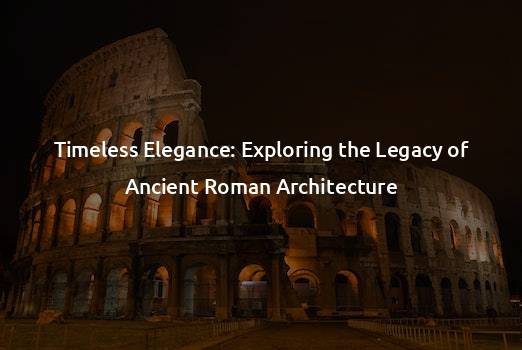Timeless Elegance: Exploring the Legacy of Ancient Roman Architecture
Timeless Elegance: Exploring the Legacy of Ancient Roman Architecture
Ancient Roman architecture stands as a testament to the remarkable ingenuity, meticulous craftsmanship, and enduring elegance of an empire that once spanned across continents, leaving an indelible mark on the world. From grand temples and palaces to awe-inspiring amphitheaters and soaring aqueducts, Roman architecture seamlessly fused artistry with engineering prowess.
As we delve into the legacy of ancient Roman architecture, we embark on a captivating journey through time, uncovering the timeless elegance that continues to inspire and influence architects, designers, and dreamers today.
The Foundations of Architectural Brilliance
At the heart of ancient Roman architecture lies an unwavering commitment to innovation, influenced by earlier architectural traditions. Roman architects seamlessly blended elements of Greek, Etruscan, and Egyptian styles to create a distinct architectural language that embodied grandeur, strength, and sophistication.
The Romans perfected the use of arches, vaults, and domes, revolutionizing structural engineering. Their pioneering mastery of concrete allowed for the creation of monumental structures that still stand today, defying the passage of time and weathering centuries of change.
The Marvels of Roman Architectural Marvels
One of the most iconic examples of Roman architecture is undoubtedly the Colosseum, a colossal amphitheater that once hosted gladiatorial contests, spectacles, and public performances. This architectural marvel, completed in 80 AD, showcases the prowess of Roman engineers who effortlessly blended functionality with aesthetics.
Another extraordinary feat of Roman architecture is the Pantheon, an ancient temple that has withstood the test of time. Constructed in 125 AD, the Pantheon exhibits a remarkable dome with a central oculus, radiating a soft glow that illuminates the space below. This architectural masterpiece is a testament to the Romans’ adeptness at achieving perfect balance and proportion.
In addition to grand structures, Roman architecture also encompassed everyday buildings such as amphitheaters, forums, and basilicas. These public spaces served as hubs for social, political, and cultural activities, adorned with intricate decorations and imposing facades that commanded attention and evoked a sense of awe.
Influences and Legacies
The influence of ancient Roman architecture is far-reaching, leaving an indelible imprint on subsequent architectural styles and movements. During the Renaissance, architects such as Michelangelo and Brunelleschi drew inspiration from the harmonious proportions and geometric precision of Roman architecture, infusing their creations with elements derived from ancient Rome.
As time progressed, neoclassical and Beaux-Arts architectural styles echoed the grandeur and elegance of ancient Rome, with prominent examples including the White House and the British Museum. Even modern architects often pay homage to the Romans, incorporating elements of Roman design into contemporary structures, establishing a timeless link between the past and the present.
The Preservation of a Timeless Legacy
Efforts to preserve ancient Roman architecture have been ongoing for centuries, ensuring that its grandeur can be admired by future generations. Restoration projects, delicate excavations, and meticulous conservation work aim to retain the authenticity and integrity of these ancient structures, safeguarding their timeless elegance for years to come.
One notable preservation project is the ongoing restoration of the Colosseum, aimed at reviving its former glory. This endeavor allows visitors to step back in time, marveling at the ingenuity and grandeur displayed by its creators almost two millennia ago.
TLDR;
Ancient Roman architecture is a testament to the fusion of artistry and engineering. From the awe-inspiring Colosseum to the harmonious Pantheon, the Romans crafted timeless structures that continue to inspire today. The legacy of Roman architecture can be seen in subsequent architectural styles and movements, and efforts to preserve these architectural marvels ensure that their elegance will endure for generations to come.







